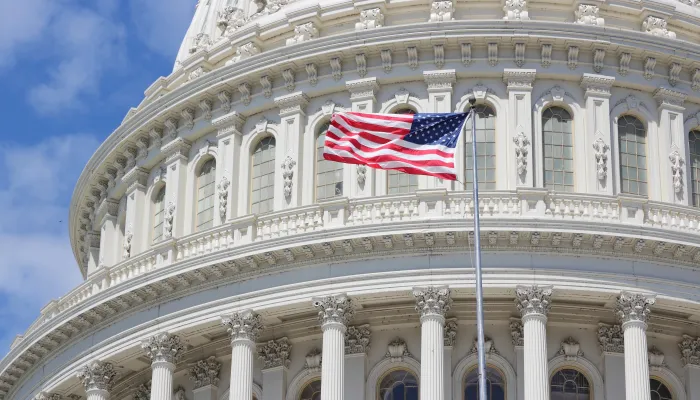America’s Truss Moment?
As the House considers a reconciliation package that is shaping up to add $3.3 trillion to the debt over a decade as written – or $5.2 trillion if temporary provisions are made permanent – interest rates have been rising. Since the beginning of the month, the 10-year Treasury yield has increased by roughly 30 basis points, from 4.2 to 4.5 percent. Yields are almost a percentage point higher than they were late last summer.
In September of 2022, a similar and much more pronounced situation happened in the United Kingdom, when then-Prime Minister Liz Truss proposed a large deficit-financed “mini-budget,” sparking turmoil in the UK bond market. There are many differences between the US and the UK that might allow the US to avoid a similar “Truss moment.” But the US’ current fiscal situation is worse than the United Kingdom’s was, and the deficit impact of the package currently under consideration is even larger than the Truss package. The markets may not take too kindly to this.

What Happened in the UK in 2022?
On September 23, 2022, the UK’s Chancellor of the Exchequer, the UK finance minister, announced a “mini-budget” that, as written, provided temporary relief for households on energy prices along with permanent tax cuts. The budget would have increased primary deficits by 1.5 percent of GDP in 2027, bringing the total estimated deficit to about 3.9 percent of GDP according to the Institute for Fiscal Studies. Amid already weak demand for government debt securities at the time and underlying inflation concerns, bond yields surged. The UK’s 30-year Gilt – the equivalent of a 30-year US Treasury – rose more than 160 basis points in just three days, with intraday volatility as high as 127 basis points.
In response, Prime Minister Truss fired the Chancellor, abandoned her proposal, and eventually resigned. By November, the new Chancellor then announced a plan of fiscal consolidation. And in the interim, the Bank of England stepped in with a variety of measures (including buying bonds from the market) to calm the turmoil.
How Does the US Situation Compare?
The US finds itself in a comparable situation today to the UK in 2022. Like in the UK, policymakers are pursuing a combination of temporary and permanent deficit-increasing policies that would significantly worsen near-term borrowing and the fiscal outlook.
We estimate that the current House package would increase the primary deficit by roughly 1.7 percent of GDP in 2027, which is even larger than the UK’s 1.5 percent of GDP budget impact in that same year. Importantly, the first two years of the mini-budget had a larger deficit impact due to temporary energy subsidy spending. For example, the deficit impact in 2023 of Truss’ mini-budget would have been about 2.6 percent of GDP, larger than the House package’s projected impact in 2026.
Of note, the fiscal situation of the US today is much worse than it was in the UK. In March of 2022, the UK Office for Budget Responsibility projected that public sector net debt would decline from about 96 percent of GDP in 2022 to 83 percent by 2027, and net borrowing would fall from 5.4 percent of GDP to 1.1 percent over the same timeframe. Today, the Congressional Budget Office’s current law baseline has US debt held by the public growing from about 100 percent of GDP today to 117 percent by 2034, with deficits between 5.2 percent of GDP and 6.5 percent over the period.
And like in the UK in 2022, yields for Treasuries have been elevated due to tight monetary policy and heightened inflation concerns. Inflation in the UK was 8 percent in 2022, which is much higher than estimates in the US today – which show as high as 4 percent inflation by the end of 2025. As a result of underlying inflation pressures, the Federal Reserve has cautiously kept interest rates at an elevated level of 4.25 to 4.50 percent, higher than the Bank of England’s policy rate of 2.25 percent in September of 2022. Importantly, the Bank of England was still in a hiking cycle as of September and investors were expecting rates to rise further; US investors today are expecting rates to fall in the future.
2022 UK Mini-Budget vs. House Reconciliation Package
| UK 2022 | US 2025 | |
|---|---|---|
| Select Metrics | ||
| Primary Deficit Impact of Proposal in 2027 | 1.5% of GDP | 1.7% of GDP |
| Total Deficit Under Proposal in 2027^ | 3.9% of GDP | 7.0% of GDP |
| Deficit in Year of Announcement’ | 5.4% of GDP | 6.2% of GDP |
| Debt in Year of Announcement* | ~96% of GDP | ~100% of GDP |
| 10-Year Yield Before Announcement | ~3.0% | ~4.3% |
| 10-Year Yield After Announcement | ~4.4% | TBD |
Sources: Committee for a Responsible Federal Budget, HM Treasury, Office for Budget Responsibility, Congressional Budget Office, and Institute for Fiscal Studies.
* US debt figures reflect debt held by the public provided by the Congressional Budget Office, while UK debt figures reflect public sector net debt provided by the Office for Budget Responsibility.
^ The UK figure was estimated by the Institute for Fiscal Studies.
' The UK figure was estimated by the Office for Budget Responsibility.
Avoiding an American Truss Moment
Although there are many similarities between the UK in 2022 and the US today, there are many differences. For example, investors are not expecting the Federal Reserve to raise rates going forward, markets may already be pricing in some of the borrowing proposed by the House, and financial regulations in the US differ.
Still, the US is not immune to bond market pressures, and a number of financial institutions are already warning that the package exceeds their prior expectations by raising serious concerns about the fiscal outlook. To avoid the risk of near-term financial turmoil – and long-term fiscal disaster – Congress should abandon its efforts to add trillions of dollars to the debt in favor of a more fiscally responsible approach.
Reconciliation should be used for its original intent – to reduce deficits – or at least should be used to pass a budget-neutral and gimmick-free package. Lawmakers could accomplish this by scaling back new tax priorities, prioritizing pro-growth and fiscally responsible extension of TCJA provisions, and further building on proposed offsets.
A thoughtful package of tax and spending reforms could help to improve debt sustainability, strengthen economic growth, lower interest rates, reduce inflationary pressures, promote investment, and make the government and tax code more efficient. And it could help the US avoid its Truss moment.


